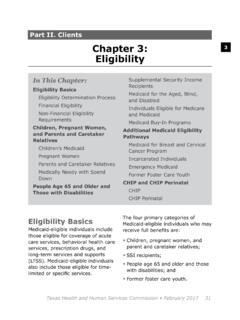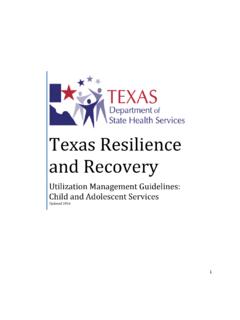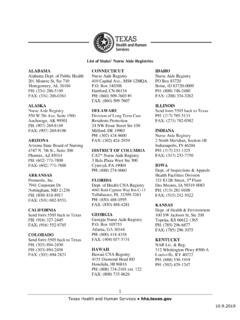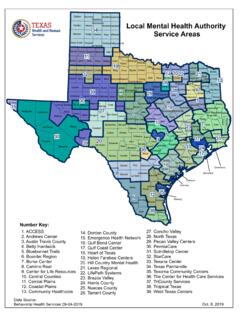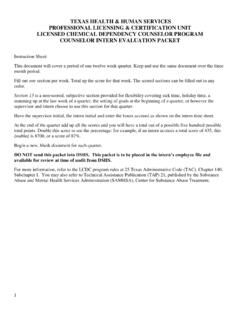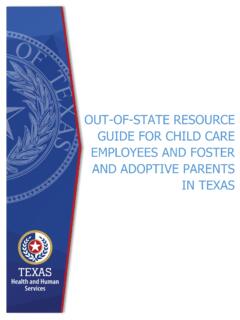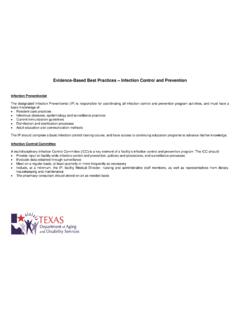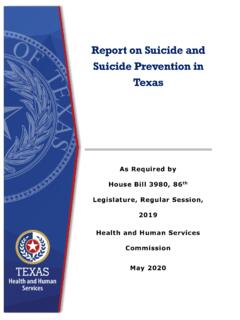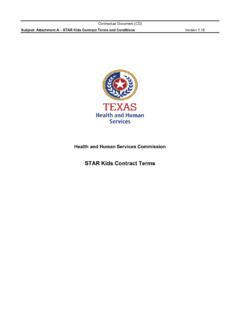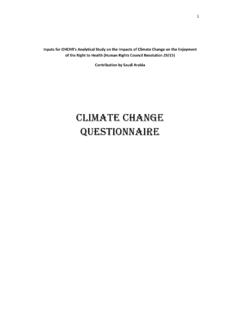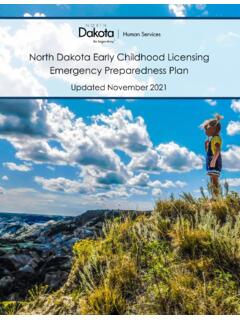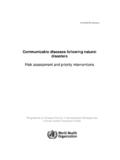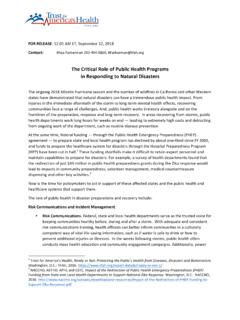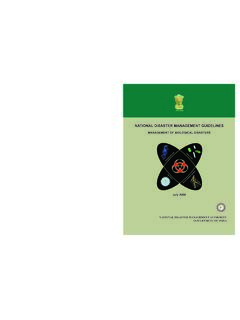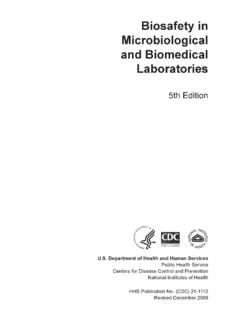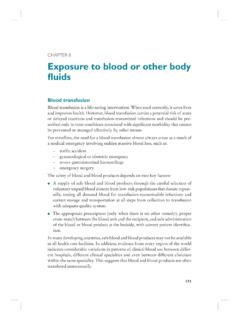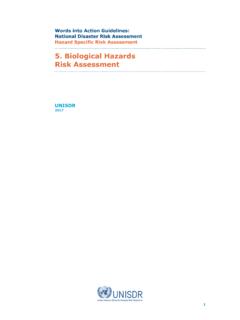Transcription of Emergency Preparedness Guidance for Nursing Homes
1 Emergency Preparedness Guidance for Nursing Homes Long-Term Care Regulatory HHSC. March 2020. Table of Contents 1. Introduction .. 1. 2. State Rules .. 2. The Plan ..2. Risk Assessments ..2. Core Function: Warning ..3. Core Function: Core Function: Sheltering Arrangements ..4. Core Function: Health and Medical Needs ..4. Core Function: Resource Management ..5. Training ..5. Self-Reported Incidents ..5. 3. Federal 6. The All-Hazards Approach ..6. The Emergency Plan ..7. Risk Assessment (E-0006) ..7. Emergency Plan: Coordination (E-0009) ..7. Policies and Procedures (E-0013) ..8. Policies and Procedures: Provision of Needs (E-0015) ..8. Policies and Procedures: Sheltering-in-Place ..9. Policies and Procedures: Emergency Staffing ..9. Communication Plan (E-0029) .. 10. Training (E-0036) .. 11. Testing (E-0039) .. 11. 4. Additional Resources .. 12. 5. Emergency Preparedness Tool (NF) .. 13. ii 1. Introduction Emergency Preparedness rules are by nature general, because emergencies can take many forms.
2 In Texas, we are most used to seeing weather-related emergencies, and facilities are most used to planning for those disasters most common to their geographical area. However, the facility should plan for all emergencies, and an infectious disease outbreak is one that can strike any facility . whether it is COVID-19, the flu, or any other infectious disease. In this presentation, we will look at the existing regulations, but give examples, scenarios and considerations based on the infectious disease outbreak type of Emergency situation. The state rules for Emergency Preparedness are in the Texas Administrative Code (40 TAC ). Federal rules are found in Appendix Z of the State Operations manual. This resource reviews relevant sections of the rules, starting with the state rules. Texas rules define the term Emergency situation and an infectious disease outbreak falls under the definition. The definition excludes a situation that arises from the medical condition of a resident, such as cardiac arrest or cerebrovascular accident.
3 1. 2. State Rules Texas rules define the term Emergency situation and an infectious disease outbreak falls under the definition. The definition excludes a situation that arises from the medical condition of a resident, such as cardiac arrest or cerebrovascular accident. The Plan The facility's Emergency plan must be: In writing and accessible to staff Evaluated at least annually Revised upon changes Includes a description of the facility's resident population, sections for the 8. core functions, the fire plan, and reporting The NF must have an Emergency plan. It must be written and a current copy must be accessible to staff throughout the facility. Each supervisor who has responsibility under the plan must also have a current copy. The NF must evaluate the plan every year, and also following a disaster or remodeling of the facility. They must revise the plan within 30 days of a change to the information in the plan. Risk Assessments A facility's Emergency plan must include a risk assessment of all potential internal and external Emergency situations relevant to the facility's operations and geographical area.
4 An emerging infectious disease outbreak is an example of a relevant Emergency situation. Because a Nursing home is a congregate living environment and with residents who are generally at high risk for complications from infection, we would expect a facility to have a risk assessment for an infectious disease outbreak. 2. Core Function: Warning A facility's plan must have a section for warning that addresses: Communication with outside entities Monitoring of news information The facility has to designate an EPC, or Emergency Preparedness Coordinator. The facility's plan must state how the EPC finds out about an Emergency situation and who the EPC notifies of the Emergency after finding out. In an outbreak, timely information about the situation is essential to preventing the spread of illness. Not having a designated EPC or communication protocols could delay the implementation of isolation or other safety measures, thus enabling the spread of disease.
5 Note that other sections of the TAC require the facility to notify DSHS of infectious diseases. Also included under warning is how the facility gets information. In a weather- related Emergency , facilities may monitor news channels and weather reports. While the news channels may report on COVID-19, we would encourage the facility to obtain information on outbreaks from DSHS or CDC. Both agencies have a COVID-19 webpage, with reliable, current information. Core Function: Communication In an outbreak, as with an Emergency , residents' families are likely to want current information on resident status. The Emergency plan's communication section is where the facility describes how community members obtain information from the facility. This is particularly relevant in an outbreak type of Emergency , should the facility be forced to isolate residents or implement a quarantine. The communication function includes requirements related to ensuring phone lists for staff and for resident responsible parties is current and available.
6 Some of the state requirements, such as for receiving facilities, would not generally apply to an outbreak ( , quarantine is a more likely response than evacuation). However, current contact information and procedures are an essential part of communication. 3. Core Function: Sheltering Arrangements A facility's plan must have a section for sheltering arrangements that includes procedures for implementing a decision to shelter-in-place that includes having access to medications, records, food, water, equipment and supplies. COVID-19 quarantines in other countries and for evacuees to the US have typically lasted 14-28 days. What are the facility's plans for obtaining food and supplies in the event of a quarantine? How will the facility ensure that equipment and physical plant repairs, if needed, can be performed? The next two core functions, Evacuation and Transportation, are not likely to apply to an infectious disease outbreak.
7 However, they are required components of the facility's Emergency plan, and must be present. Core Function: Health and Medical Needs What is the facility's plan if outside providers, such as dialysis centers, are closed or unable to provide services to the residents? The facility is required to provide ordered services, even during a disaster . 4. Core Function: Resource Management A facility must also identify staff who are assigned to locate the above items. What is the facility's plan for ensuring uninterrupted supplies of medications and supplies? For example, what is the facility doing to ensure that sufficient, non- expired Personal Protective Equipment (PPE), such as masks, is available to staff? Training A facility must train staff on their responsibilities under the plan within 30 days after they assume job duties. The training must also occur at least annually and when a staff member's responsibilities under the plan change.
8 The training part of the rule also requires an annual drill for a natural disaster . While we would not expect an infectious disease outbreak drill specifically, if the facility's documentation must show that a drill was performed. Self-Reported Incidents A facility must report an Emergency situation that caused the death or serious injury of a resident to HHSC by calling 1-800-458-9858 immediately after the death or serious injury. See Provider Letter #19-17 for more Guidance . For infectious diseases, the facility is required to report to the local health department, regardless of whether death or serious injury occurred. In the case of COVID-19, DSHS and CDC will immediately evaluate the situation. 5. 3. Federal Rules The federal rules are in Appendix Z of the State Operations Manual (SOM). The Centers for Medicare & Medicaid Services publishes the SOM. Appendix Z addresses Emergency Preparedness rules for all provider and supplier types, including providers that LTCR doesn't regulate.
9 CMS recently revised Appendix Z; however, for Nursing facilities, the changes were limited. The requirements are focused on three key essentials necessary for maintaining access to healthcare during disasters or emergencies: safeguarding human resources, maintaining business continuity, and protecting physical resources. You will also find the rules in the Code of Federal Regulations (42 CFR. ). The All-Hazards Approach An all-hazards approach is an integrated approach to Emergency Preparedness that focuses on identifying hazards and developing Emergency Preparedness capacities and capabilities that can address those as well as a wide spectrum of emergencies or disasters. Appendix Z specifically states that the Emergency plan should include planning for emerging infectious disease threats. 6. The Emergency Plan The plan: Must comply with state/local/tribal law (E-0001). Must be reviewed & updated at least annually (E-0004). Must address resident population (E-0006).
10 Note the difference between state and federal law. The state rules require a plan to be evaluated annually, but only updated within 30 days of a change. The federal language requires both review and updating at least annually and does not specify a timeframe for updates after a change. The plan must address the facility's resident population, including, but not limited to, persons at-risk; the type of services the LTC facility has the ability to provide in an Emergency ; and continuity of operations, including delegations of authority and succession plans. Per E-0042, if the NF is part of an integrated healthcare system (consisting of a number of separately certified providers), they can choose to participate in the healthcare system's Emergency Preparedness program; however they have to be able to show that the facility participated in the development of the program and that the program takes into account the NF's unique circumstances, services, and population, and the NF has to be able to implement and comply with the program.
